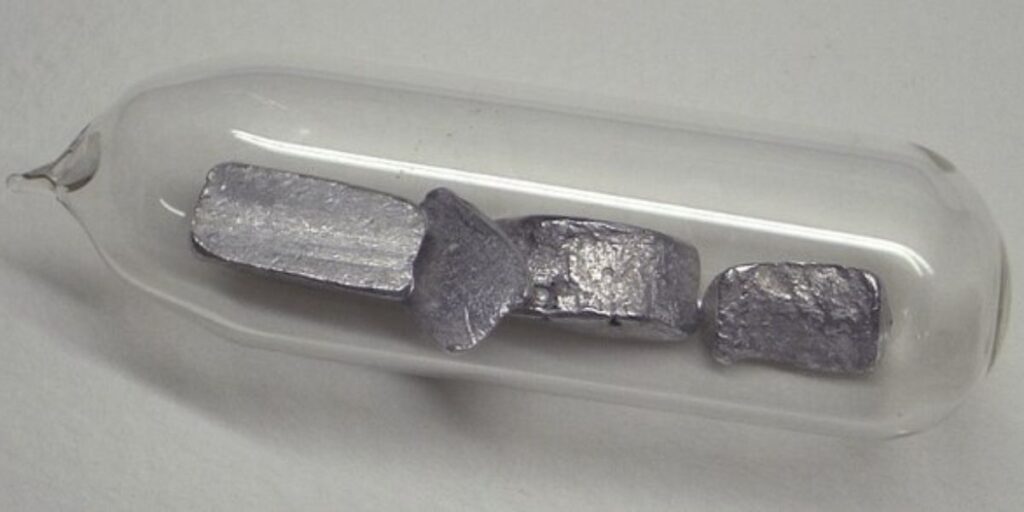Thalium is a chemical element that most people don’t hear about every day, but it plays a big role in science and industry. While it might sound unfamiliar, this soft, silvery metal has a history of both usefulness and danger. If you’re curious about what thalium is, how it’s used, and why it’s considered highly toxic, this article will explain everything in simple words.
Let’s explore what makes thalium so unique and why it’s both a powerful tool and a serious hazard.
What is Thalium?
Thalium is a chemical element with the symbol Tl and atomic number 81. It’s part of the metal family and is known for being soft, malleable, and silvery-gray in color when freshly cut. However, it quickly turns dull as it reacts with air.
Thalium was discovered in 1861 by a scientist named William Crookes, who found it while studying residues left behind after burning certain minerals. The name “thalium” comes from the Greek word “thallos”, meaning green shoot, because of the bright green line it showed in a special kind of light analysis called spectroscopy.
Where is Thalium Found?
Thalium isn’t found freely in nature but occurs in small amounts in minerals like:
-
Crookesite
-
Lorandite
-
Pyrite
-
Sphalerite
It’s often obtained as a byproduct while refining other metals like zinc and copper.
Even though thalium is rare, small amounts can be found in soil, water, and even some plants. However, these tiny traces are usually not harmful to humans unless they build up over time.
Properties of Thalium
Here are some key properties of thalium:
-
Symbol: Tl
-
Atomic Number: 81
-
State: Solid at room temperature
-
Color: Silvery white (but tarnishes easily)
-
Softness: Can be cut with a knife
-
Melting Point: 304°C (579°F)
-
Toxicity: Extremely poisonous to humans and animals
Because of its softness and chemical reactivity, thalium must be handled carefully, especially in pure form.
Uses of Thalium
Although thalium is toxic, it still has some important uses in various industries. Let’s look at how thalium is used today:
1. Electronics and Semiconductors
Thalium is used in semiconductors, photocells, and infrared detectors because it conducts electricity in special ways. It’s helpful in making highly sensitive equipment for research and defense.
2. Optics and Glass
Certain types of special optical glass contain thalium to improve clarity and performance. These are often used in scientific instruments or night-vision equipment.
3. Medical Imaging (Past Use)
In the past, a form of radioactive thalium was used in nuclear medicine, especially in heart imaging tests. It helped doctors see how well blood flows through the heart. Today, this use has declined because of safety concerns and the availability of safer alternatives.
4. Rat Poison and Insecticides (Historic Use)
Thalium was once used as a powerful rat poison and insecticide, but it’s now banned in most countries because of how toxic it is to humans, pets, and wildlife.
Why is Thalium Dangerous?
One of the most important things to know about thalium is that it’s extremely toxic, even in small amounts. It can enter the body through inhalation, skin contact, or swallowing.
Symptoms of Thalium Poisoning Include:
-
Nausea and vomiting
-
Hair loss (a unique sign of thalium poisoning)
-
Nerve damage
-
Skin pain or rash
-
Confusion or memory loss
-
Organ failure in severe cases
Because it can mimic potassium in the body, thalium can interfere with normal cell functions, making it especially dangerous.
How Do People Get Exposed to Thalium?
Exposure to thalium is rare but can happen in:
-
Industrial workplaces where thalium compounds are used
-
Mining and metal refining operations
-
Contaminated food or water (very rare)
-
Illegal use in poisonings (unfortunately, thalium has been misused in crimes)
That’s why most countries have strict regulations for thalium use, storage, and disposal.
How is Thalium Poisoning Treated?
If someone is poisoned by thalium, they need immediate medical help. Treatment usually includes:
-
Activated charcoal to absorb the poison (if taken recently)
-
Prussian blue, a special medicine that binds to thalium and helps the body remove it
-
Supportive care for symptoms like nerve pain or organ issues
Early detection is key to survival, as thalium poisoning can become life-threatening very quickly.
Environmental Impact of Thalium
Even though it’s used in small amounts, thalium can be dangerous to the environment if not handled properly. It can:
-
Pollute water sources
-
Harm fish and wildlife
-
Build up in soil and plants
That’s why industries that use thalium must follow strict environmental safety rules.
Is There Thalium in Food or Water?
In most areas, food and water do not contain harmful levels of thalium. However, trace amounts may be present in:
-
Certain leafy vegetables
-
Root crops grown in thalium-contaminated soil
-
Industrial runoff near metal mines
Because of this, environmental health organizations monitor water and soil for thalium levels to keep people safe.
Thalium in Crime Stories
Due to its poisonous nature and lack of smell or taste, thalium has sadly been used in criminal poisoning cases. It was known as the “poisoner’s poison” in the mid-1900s.
These cases led to stronger laws and the banning of thalium in household products in many countries.
Interesting Facts About Thalium
-
Thalium is so soft it can be cut with a butter knife.
-
It forms bright green flames when burned.
-
One of the early signs of poisoning is hair loss, which is very unusual among toxic substances.
-
Thalium was once used in thermometers and low-temperature glass, but not anymore due to safety concerns.
-
It can be deadly in doses as small as 1 gram.
Conclusion
Thalium is a fascinating element with a mix of science, history, and caution. It’s used in electronics, optical devices, and research — but it’s also known for being highly poisonous. While it has some practical applications, thalium must be handled with extreme care to avoid health and environmental risks.
- Thallium Poisoning: Symptoms, Sources & Prevention
- Thalium is used in semiconductors, photocells, and infrared detectors because it conducts electricity in special ways. It’s helpful in making highly sensitive equipment for research and defense.
- #Thalium
Related posts:
 Fitness for Mental Clarity: Unlock Your Focus and Inner Strength with DG FIT MIND
Fitness for Mental Clarity: Unlock Your Focus and Inner Strength with DG FIT MIND
 Top Carrier Oil Suppliers in India for Bulk & Wholesale Buyers
Top Carrier Oil Suppliers in India for Bulk & Wholesale Buyers
 Atlas Pro ONTV : La Révolution de la Télévision par Internet
Atlas Pro ONTV : La Révolution de la Télévision par Internet
 Essentials Hoodie Design Philosophy: Minimalism Meets Statement
Essentials Hoodie Design Philosophy: Minimalism Meets Statement
 Make Your Message Stick: The Power of Flyers & Posters in Plano!
Make Your Message Stick: The Power of Flyers & Posters in Plano!
 Integrating Type form with High Level: A Comprehensive Guide
Integrating Type form with High Level: A Comprehensive Guide
 What Solar Looks Like on Flat Roofs, Metal Roofs, and Shingles?
What Solar Looks Like on Flat Roofs, Metal Roofs, and Shingles?
 When Best Stock Market Institute Delhi Becomes Your Turning Point Forever
When Best Stock Market Institute Delhi Becomes Your Turning Point Forever








